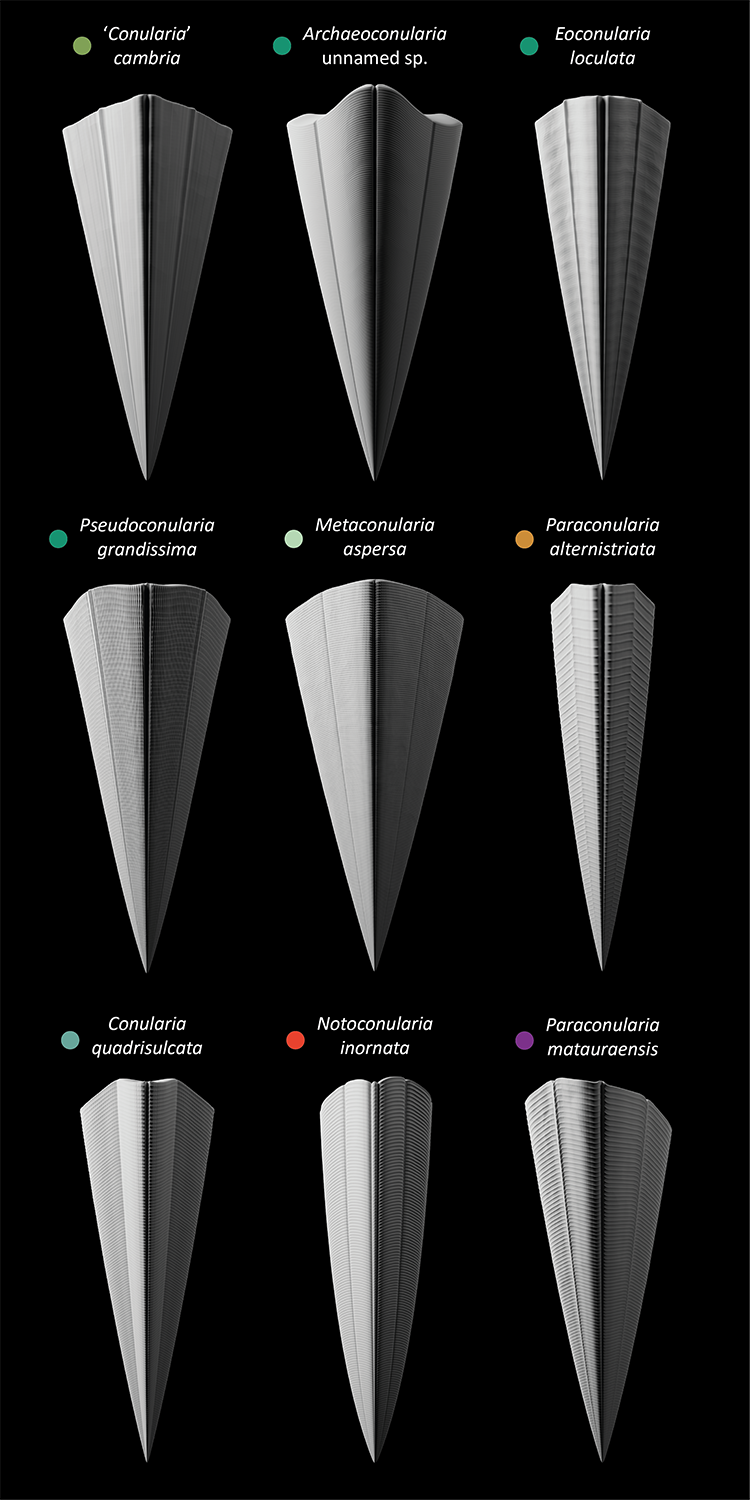#notoconularia
Text

Conulariids are an extinct group of probable cnidarians with 4-sided pyramidal thecae. They are relatively uncommon fossils but ranged from the Cambrian (possibly Ediacaran?) to the Triassic, comprising tens of genera and hundreds of described species (Lucas 2012).
Here are the reconstructed thecae of a small selection of species from every period of the conulariids' range, starting from the Cambrian in the top left and reaching all the way to the Triassic in the bottom right.
Since their soft parts are virtually never preserved (due to them being cnidarians and all that) (Van Iten & Südkamp 2010), most of our knowledge of conulariid biology and evolution is based on their more fossil-friendly thecae, which were composed of thin organophosphatic lamellae (Leme et al. 2008). Live conulariids were attached to the substrate by the apex of their theca; they probably captured suspended food particles or small prey using tentacles, just like other cnidarians, but it's hard to go in any more (non-speculative) detail without preserved soft tissues.
References:
Babcock, L. E. (1986). Devonian and Mississippian conulariids of North America. Part B. Paraconularia, Reticulaconularia, new genus, and organisms rejected from Conulariida. Annals of the Carnegie Museum, 55, 411–479. https://doi.org/10.5962/p.215204
Guimarães Simões, M., Coelho Rodrigues, S., Moraes Leme, J. de, & Van Iten, H. (2003). Some Middle Paleozoic Conulariids (Cnidaria) as Possible Examples of Taphonomic Artifacts. Journal of Taphonomy, 1(3), 163–184.
Hughes, N. C., Gunderson, G. O., & Weedon, M. J. (2000). Late Cambrian Conulariids from Wisconsin and Minnesota. Journal of Paleontology, 74(5), 828–838. https://doi.org/10.1666/0022-3360(2000)074<;0828:LCCFWA>2.0.CO;2
John, D. L., Hughes, N. C., Galaviz, M. I., Gunderson, G. O., & Meyer, R. (2010). Unusually preserved Metaconularia manni (Roy, 1935) from the Silurian of Iowa, and the systematics of the genus. Journal of Paleontology, 84(1), 1–31. https://doi.org/10.1666/09-025.1
Leme, J. M., Simões, M. G., Marques, A. C., & Van Iten, H. (2008). Cladistic Analysis of the Suborder Conulariina Miller and Gurley, 1896 (cnidaria, Scyphozoa; Vendian–Triassic). Palaeontology, 51(3), 649–662. https://doi.org/10.1111/j.1475-4983.2008.00775.x
Lucas, S. (2012). The Extinction of the Conulariids. Geosciences, 2, 1–10. https://doi.org/10.3390/geosciences2010001
Sendino, C., & Zagorsek, K. (2011). The Aperture and Its Closure in an Ordovician Conulariid. Acta Palaeontologica Polonica, 56, 659–663. https://doi.org/10.4202/app.2010.0028
Slater, I. L. (1907). A monograph of British Conulariæ. Printed for the Palæontographical Society.
Thomas, G. A. (1969). Notoconularia, a New Conularid Genus from the Permian of Eastern Australia. Journal of Paleontology, 43(5), 1283–1290.
Van Iten, H., Konate, M., & Moussa, Y. (2008). Conulariids of the Upper Talak Formation (Mississipian, Visean) of Northern Niger (West Africa). Journal of Paleontology, 82(1), 192–196. https://doi.org/10.1666/06-083.1
Van Iten, H., Muir, L., Simões, M. G., Leme, J. M., Marques, A. C., & Yoder, N. (2016). Palaeobiogeography, palaeoecology and evolution of Lower Ordovician conulariids and Sphenothallus (Medusozoa, Cnidaria), with emphasis on the Fezouata Shale of southeastern Morocco. Palaeogeography, Palaeoclimatology, Palaeoecology, 460, 170–178. https://doi.org/10.1016/j.palaeo.2016.03.008
Van Iten, H., & Südkamp, W. H. (2010). Exceptionally preserved conulariids and an edrioasteroid from the Hunsrück Slate (Lower Devonian, SW Germany). Palaeontology, 53(2), 403–414. https://doi.org/10.1111/j.1475-4983.2010.00942.x
Waterhouse, J. B. (1979). Permian and Triassic conulariid species from New Zealand. Journal of the Royal Society of New Zealand, 9(4), 475–489. https://doi.org/10.1080/03036758.1979.10421833
敏郎杉山. (1942). 156. 日本産Conularidaの研究. 日本古生物学會報告・紀事, 1942(25), 185-194_1. https://doi.org/10.14825/prpsj1935.1942.185
#conularia#archaeoconularia#eoconularia#pseudoconularia#metaconularia#paraconularia#notoconularia#conulariid#cnidarian#paleozoic#mesozoic#palaeoblr#paleoart#my art
40 notes
·
View notes